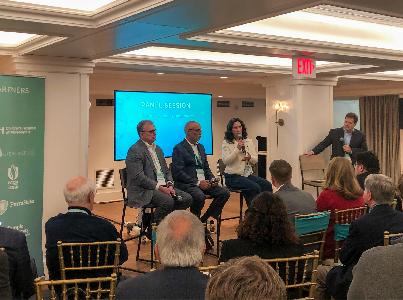Forty percent of, or at least 230,000, Philadelphia households are without Internet access, according to a speech Mayor Nutter gave last week, introducing the Comcast Internet Essentials low-cost web offer to the city.
That disparity is concentrated in very specific areas: for example, just 10 percent of Kensington homes have Internet access while in Society Hill, the number is beyond 90 percent, Nutter said.
When the majority of residents in a given area do not have Internet access, the entire community is at a disadvantage. Web-enabled computers are among the most overwhelmed resources at Free Library branches, as residents seek and apply for jobs, students research and do school work and everyone tries to keep up with normalizing communication patterns.
For years, this divide has been on the minds of both city government and businesses both local and national, and a variety of initiatives have taken root recently.
On the city government side, around $25 million in federal stimulus money has been spent toward bridging this divide, largely put under the broad FreedomRings initiative. Those funds have been earmarked for 77 computing centers around the city, many of them set to be mobile and 30 of which are currently operational.
These centers provide free Internet access to children looking to complete homework assignments and adults who are seeking jobs or educational opportunities. If a person using any of these centers does not possess the knowledge of how to use the Internet or a computer in general, the staff at these centers hold classes to educate people on how to use the Internet as a tool to educate themselves, improve or create new ways for people to earn a livelihood. Mayor Nutter has touted these centers for both educating the public and providing jobs in the city.
The Free Library has sought to expand its online offerings through a new Knight Foundation-funded service called Free Library Hot Spots, where residents can go to use free Internet. The Hot Spots are equipped with computers and printers, and computer assistants oversee the Hot Spots to provide any information and help to users.
Additionally, wireless Internet access has been rolled out at all library locations. Users can bring their own laptop or wireless device to any Free Library and utilize the Internet connection. This provision of web access offers those who cannot afford to have wireless Internet in their own home to stay connected.
Like the federally funded computing centers, the Free Library also offers a number of computer training courses, including classes that cover the basics of computers and the internet, intended for individuals with little to no experience with technology.
Businesses are getting in on the act as well, most recently noted with the Philadelphia launch of Internet Essentials from Comcast, a low-cost Internet option the company is rolling out in all of its markets as part of its deal with the FCC to gain approval for its bid to acquire a majority stake in NBC Universal.
The program, for qualifying families with children who are receiving free school lunches, can receive monthly Internet access with up to 1.5 Mbps for around $10 a month and a $150 voucher for what Comcast calls “a low-cost computer.”
Verizon Wireless and AT&T have both been upgrading their mobile network connections, often pitching the advancements as a way to make smartphone connectivity an answer to the digital divide. Notably, Pew research has shown that mobile phone web-usage in some black and Hispanic communities can outpace that of white users.
Join the conversation!
Find news, events, jobs and people who share your interests on Technical.ly's open community Slack

Philly daily roundup: Women's health startup wins pitch; $204M for internet access; 'GamingWalls' for sports venues

Philly daily roundup: East Market coworking; Temple's $2.5M engineering donation; WITS spring summit

Philly daily roundup: Jason Bannon leaves Ben Franklin; $26M for narcolepsy treatment; Philly Tech Calendar turns one

